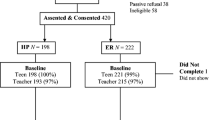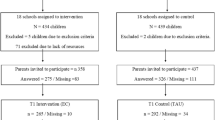Abstract
The paper examined the effectiveness of an in-school intervention for adolescents designed to target emotional regulation skills related to risky behaviors. The Cognitive Emotion Regulation Intended for Youth (CERTIFY) program was delivered to at-risk adolescents in Montreal, Canada. Participants were drawn from an alternative high school and a dropout prevention program within an urban high school. The pilot was a student-focused therapeutic modality without parental intervention for maladaptive cognitive emotion regulation (CER) and engagement in risky behaviors. CERTIFY is a school-based group intervention targeting CER strategies and was implemented with 28 adolescents from two English language secondary schools. The intervention was conducted for 12 weeks for the intervention group versus controls who were offered usual school supports. Program outcomes were evaluated using the Cognitive Emotion Regulation Questionnaire and Risky Behaviors Questionnaire for Adolescents. The intervention group made significant gains with regard to using adaptive CER strategies. Specifically, the intervention resulted in increases in self-reported use of positive reappraisal and refocusing on planning. No significant gains were found for reducing the use of maladaptive CER strategies or risky behaviors. This school-based intervention program for high-risk adolescents increased overall use of adaptive CER strategies and provided insight for future intervention design.
Similar content being viewed by others
References
Agostin, T. M., & Bain, S. K. (1997). Predicting early school success with developmental and social skills screeners. Psychology in the Schools, 34, 219–228. doi:10.1002/(SICI)1520-6807(199707)34:3<219::AID-PITS4>3.0.CO;2-J.
Aldao, A., Nolen-Hoeksema, S., & Schweizer, S. (2010). Emotion-regulation strategies across psychopathology: a meta-analytic review. Clinical Psychology Review, 30, 217–237. doi:10.1016/j.cpr.2009.11.004.
Aldwin, C. (1994). Stress, coping, and development. New York, NY: Guilford.
Arnett, J. J. (1999). Adolescent storm and stress, reconsidered. American Psychologist, 54, 317–326. doi:10.1037/0003-066X.54.5.317.
Auerbach, R. P., & Gardiner, C. K. (2012). Moving beyond the trait conceptualization of self-esteem: the prospective effect of impulsiveness, coping, and risky behavior engagement. Behaviour Research and Therapy, 50, 596–603. doi:10.1016/j.brat.2012.06.002.
Auerbach, R. P., Abela, J. R. Z., & Ho, M. R. (2007a). Responding to symptoms of depression and anxiety: emotion regulation, neuroticism, and engagement in risky behaviors. Behaviour Research and Therapy, 45, 2182–2191. doi:10.1016/j.brat.2006. 11.002.
Auerbach, R. P., Abela, J. R. Z., Zhu, X., & Yao, S. (2007b). A diathesis-stress model of engagement in risky behaviors in Chinese adolescents. Behaviour Research and Therapy, 45, 2850–2860. doi:10.1016/j.brat.2007.05.005.
Auerbach, R. P., Claro, A., Abela, J. R. Z., Zhu, X., & Yao, S. (2010a). Understanding risky behavior engagement amongst Chinese adolescents. Cognitive Therapy and Research, 34, 159–167. doi:10.1007/s10608-009-9238-x.
Auerbach, R. P., Tsai, B., & Abela, J. R. Z. (2010b). Temporal relationships among depressive symptoms, risky behavior engagement, perceived control, and gender in a sample of adolescents. Journal of Research on Adolescence, 20, 726–747. doi:10.1111/j.1532-7795.2010.00657.x.
Blum, R. W., & Libbey, H. P. (2004). School connectedness: strengthening health and education outcomes for teenagers. Journal of School Health, 74, 231–235. doi:10.1111/(ISSN)1746-1561.
Carroll, C., Patterson, M., Wood, S., Booth, A., Rick, J., & Balain, S. (2007). A conceptual framework for implementation fidelity. Implementation Science, 2, 40. doi:10.1186/1748-5908-2-40.
Carver, C. S., Scheier, M. F., & Weintraub, J. K. (1989). Assessing coping strategies: a theoretically based approach. Journal of Personality and Social Psychology, 56, 267–283. doi:10.1037/0022-3514.56.2.267.
Chen, K., Kandel, D. B., & Davies, M. (1997). Relationships between frequency and quantity of marijuana use and last year proxy dependence among adolescents and adults in the United States. Drug and Alcohol Dependence, 46, 53––67. doi:10.1016/S0376-8716(97)00047-1.
Cohen, J. (1988). Statistical power analysis for the behavioral sciences. Hillsdale, NJ: Erlbaum.
Creed, P. A., Machin, M. A., & Hicks, R. (1999). Improving mental health status and coping abilities for long-term unemployed youth using cognitive-behaviour therapy based training interventions. Journal of Organizational Behavior, 20, 963–978. doi:10.1002/(SICI)1099-1379(199911)20:63.0.CO;2-D.
Durlak, J., & Weissberg, R. P. (2010). Social and emotional learning programs that work. In R. Slavin (Ed.), Better evidence-based education: social-emotional learning (Vol. 2, pp. 4–5). York, NY: Institute for Effective Education, University of York.
Durlak, J. A., Weissberg, R. P., Dymnicki, A. B., Taylor, R. D., & Schellinger, K. B. (2011). The impact of enhancing students’ social and emotional learning: a meta-analysis of school-based universal interventions. Child Development, 82, 405–432. doi:10.1111/j.1467-8624.2010.01564.x.
Endler, N. S., & Parker, J. D. (1990). Multidimensional assessment of coping: a critical evaluation. Journal of Personality and Social Psychology, 58, 844–854. doi:10.1037//0022-3514.58.5.844.
Ennett, S. T., Tobler, N. S., Ringwalt, C. L., & Flewelling, R. L. (1994). How effective is drug abuse resistance education? A meta-analysis of Project DARE outcome evaluations. American Journal of Public Health, 84, 1394–1401. doi:10.2105/AJPH.84.9.1394.
Extremera, N., & Rey, L. (2014). Health-related quality of life and cognitive emotion regulation strategies in the unemployed: a cross-sectional survey. Health and Quality of Life Outcomes, 12, 172. doi:10.1186/s12955-014-0172-6.
Faul, F., Erdfelder, E., Buchner, A., & Lang, A. G. (2009). Statistical power analyses using G*Power 3.1: tests for correlation and regression analyses. Behavior Research Methods, 41, 1149–1160. doi:10.3758/brm.41.4.1149.
Garnefski, N., & Kraaij, V. (2006). Relationships between cognitive emotion regulation strategies and depressive symptoms: a comparative study of five specific samples. Personality and Individual Differences, 40, 1659–1669. doi:10.1016/j.paid.2005.12.009.
Garnefski, N., & Kraaij, V. (2007). The Cognitive Emotion Regulation Questionnaire psychometric features and prospective relationships with depression and anxiety in adults. Journal of Psychological Assessment, 23, 141–149. doi:10.1027/1015-5759.23.3.141.
Garnefski, N., & Kraaij, V. (2012). Effects of a cognitive behavioral self-help program on emotional problems for people with acquired hearing loss: a randomized controlled trial. Journal of Deaf Studies and Deaf Education, 17, 75–84. doi:10.1093/deafed/enr020.
Garnefski, N., & Kraaij, V. (2014). Bully victimization and emotional problems in adolescents: moderation by specific cognitive coping strategies? Journal of Adolescence, 37, 1153–1160. doi:10.1016/j.adolescence.2014.07.005.
Garnefski, N., Kraaij, V., & Spinhoven, P. (2001). Negative life events, cognitive emotion regulation and emotional problems. Personality and Individual Differences, 30, 1311–1327. doi:10.1016/S0191-8869(00)00113-6.
Garnefski, N., Van Den Kommer, T., Kraaij, V., Teerds, J., Legerstee, J., & Onstein, E. (2002). The relationship between cognitive emotion regulation strategies and emotional problems: comparison between a clinical and a non‐clinical sample. European Journal of Personality, 16, 403–420. doi:10.1002/per.458.
Garnefski, N., Teerds, J., Kraaij, V., Legerstee, J., & van den Kommer, T. (2004). Cognitive emotion regulation strategies and depressive symptoms: differences between males and females. Personality and Individual Differences, 36, 267–276. doi:10.1016/S0191-8869(03)00083-7.
Garnefski, N., Kraaij, V., & van Etten, M. (2005). Specificity of relations between adolescents’ cognitive emotion regulation strategies and internalizing and externalizing psychopathology. Journal of Adolescence, 28, 619–631. doi:10.1016/j.adolescence.2004.12.009.
Garnefski, N., Koopman, H., Kraaij, V., & Cate, R. T. (2009a). Brief report: cognitive emotion regulation strategies and psychological adjustment in adolescents with a chronic disease. Journal of Adolescence, 32, 449–454. doi:10.1016/j.adolescence.2008.01.003.
Garnefski, N., Kraaij, V., De Graaf, M., & Karels, L. (2009b). Psychological intervention targets for people with visual impairments: the importance of cognitive coping and goal adjustment. Disability and Rehabilitation, 32, 142–147. doi:10.3109/09638280903071859.
Gumora, G., & Arsenio, W. F. (2002). Emotionality, emotion regulation, and school performance in middle school children. Journal of School Psychology, 40, 395–413. doi:10.1016/S0022-4405(02)00108-5.
Jacobson, L. A., Williford, A. P., & Pianta, R. C. (2011). The role of executive function in children’s competent adjustment to middle school. Child Neuropsychology, 17, 255–280. doi:10.1080/09297049.2010.535654.
Kesek, A., Zelazo, P. D., & Lewis, M. D. (2009). The development of executive cognitive function and emotion regulation in adolescence. In N. B. Allen & L. B. Sheeber (Eds.), Adolescent emotional development and the emergence of depressive disorders (pp. 135–155). New York, NY: Cambridge University Press.
Macklem, G. L. (2008). Practitioner’s guide to emotion regulation in school-aged children. New York, NY: Springer.
Nichols, T. R., Graber, J. A., Brooks-Gunn, J., & Botvin, G. J. (2006). Sex differences in overt aggression and delinquency among urban minority middle school students. Applied Developmental Psychology, 27, 78–91. doi:10.1016/j.appdev.2005.12.006.
Oltmanns, T. F., & Emery, R. E. (1995). Abnormal psychology. Upper Saddle River, NJ: Prentice-Hall.
Pardini, D., Lochman, J., & Wells, K. (2004). Negative emotions and alcohol use initiation in high-risk boys: the moderating effect of good inhibitory control. Journal of Abnormal Child Psychology, 32, 505–518. doi:10.1023/B:JACP.0000037780.22849.23.
Ridder, D. D. (1997). What is wrong with coping assessment? A review of conceptual and methodological issues. Psychology & Health, 12, 417–431. doi:10.1080/08870449708406717.
Rosenblum, G. D., & Lewis, M. (2003). Emotional development in adolescence. Blackwell Handbook of Adolescence, 269–289. doi:10.1002/9780470756607.ch13.
Slee, N., Spinhoven, P., Garnefski, N., & Arensman, E. (2008). Emotion regulation as mediator of treatment outcome in therapy for deliberate self-harm. Clinical Psychology and Psychotherapy, 15, 205–216. doi:10.1002/cpp.577.
Steinberg, L. (2005). Cognitive and affective development in adolescence. Trends in Cognitive Sciences, 9, 69–74. doi:10.1016/j.tics.2004.12.005.
Weissberg, R. P., & O’Brien, M. U. (2004). What works in school-based social and emotional learning programs for positive youth development. The Annals of the American Academy of Political and Social Science, 591, 86–97. doi:10.1177/0002716203260093.
Author information
Authors and Affiliations
Corresponding author
Rights and permissions
About this article
Cite this article
Claro, A., Boulanger, MM. & Shaw, S.R. Targeting Vulnerabilities to Risky Behavior: an Intervention for Promoting Adaptive Emotion Regulation in Adolescents. Contemp School Psychol 19, 330–339 (2015). https://doi.org/10.1007/s40688-015-0063-9
Published:
Issue Date:
DOI: https://doi.org/10.1007/s40688-015-0063-9




